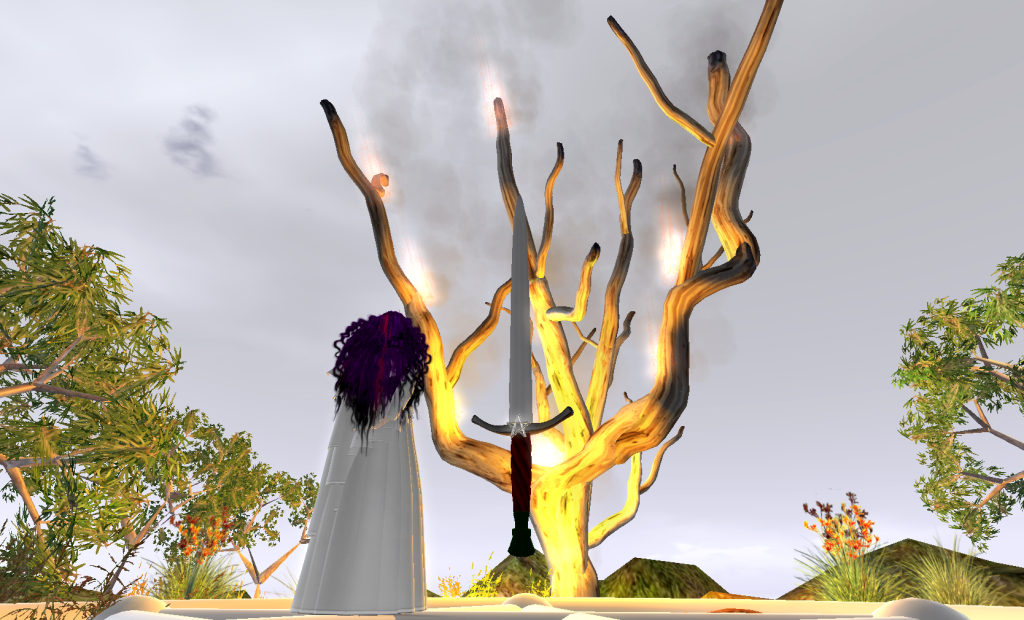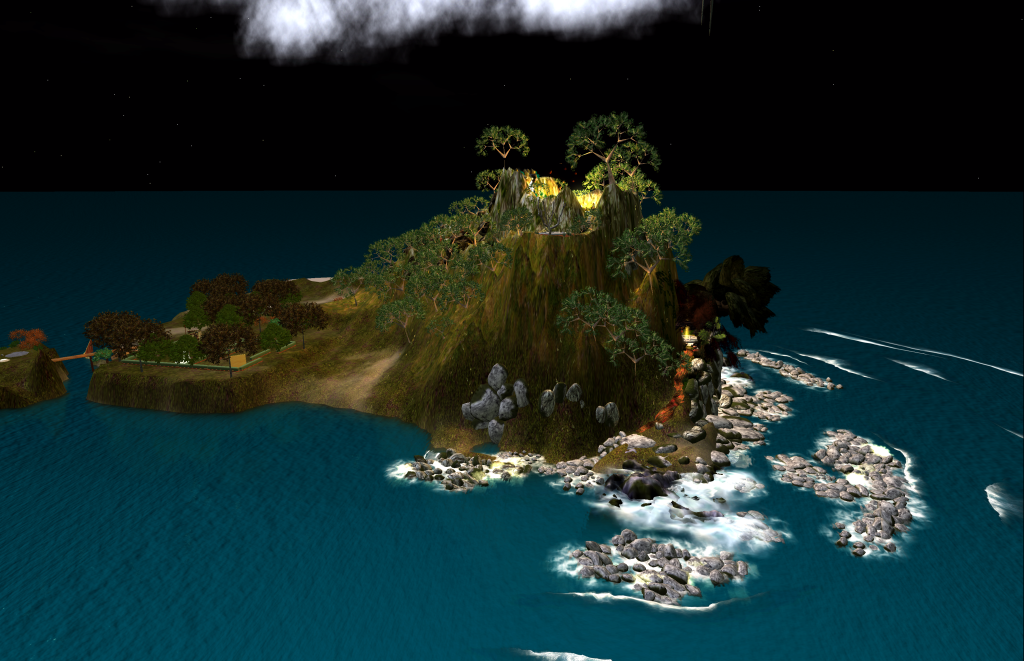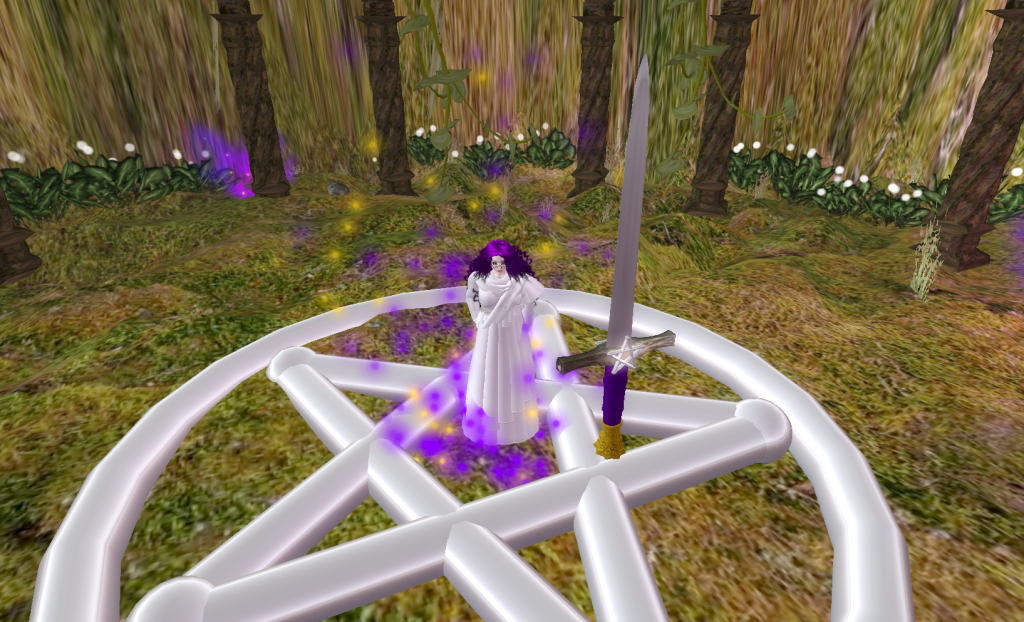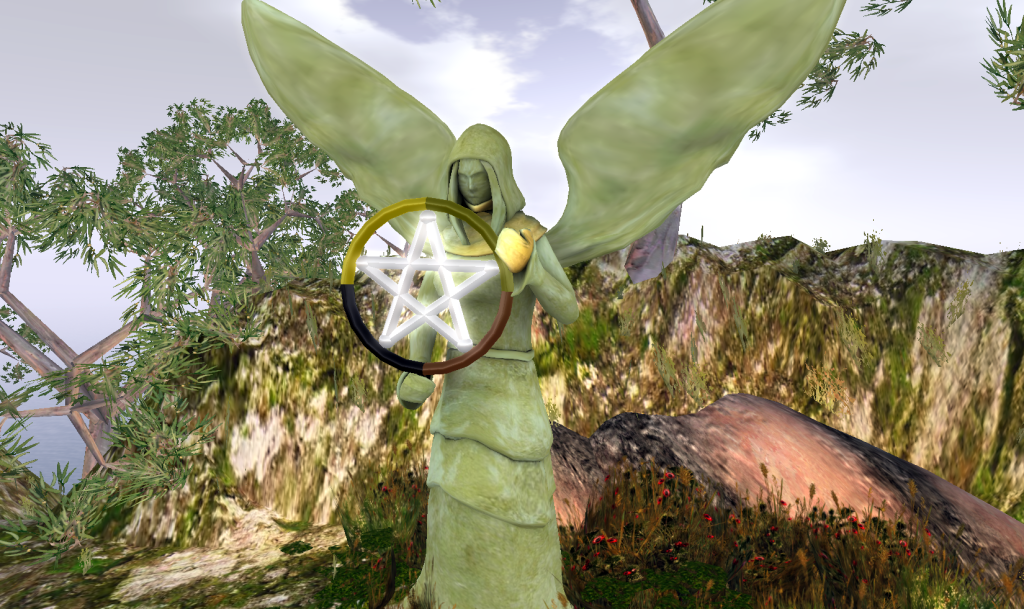Introduction
This post relates a cool thing I did while I was teaching at uni way back in 2015. It is part of my continuing effort to self host all my academic work rather than have it on Academia.edu, which is now becoming enshittified. Despite its .edu domain Academia.edu is not actually run by an educational institution. It is a private company which got its domain when .edu domains were not strictly restricted to educational institutions, and then managed to get it grandfathered once the rules were tightened1.
This teaching experience was the dawning of my realization that universities are not places where teaching is valued. But that’s a story for another day. It took the form of an immersive educational experience which undertook to role play a Pagan circle ritual in the virtual world Second Life as part of an undergraduate sociology unit at the University Of Tasmania (UTAS). I focus the discussion on the importance of fun as a vital component of learning while considering whether real educational value was achieved.

As educators expand into virtual worlds the importance of understanding the processes of digital domains increases. This leads to questions such as whether experiences in a virtual environment are authentic in themselves and whether there is real educational value in online interactive media, including games and shared virtual environments such as Second Life. An important aspect of education that is sadly often overlooked, especially at tertiary level, is fun. Csíkszentmihályi posited that people are most happy and attentive when in a state of flow2. From this we deduce that in order to achieve optimal educational value activities should induce flow.
Previous3 work has shown how Second Life can be used to increase the measurable learning achieved with similar time and resources. This work also indicated that learning can be achieved through complementing physical environment activities with virtual environment activities in a structure fostering a flow experience that would be prohibitively resource intensive in a physical environment alone. In addition to the resource efficiency of such activities, these experiences are more likely to be enjoyable.
There is not yet an established model for judging enjoyment in virtual worlds, although Sweetster and Wyeth have suggested a flow based approach4. While the study of enjoyment in virtual worlds is in its infancy it has a long history in media studies5. However there is an important fundamental difference between enjoyment of media in general and of enjoyment in education in virtual worlds: enjoyment is taken for granted in media studies6. Once the audience loses enjoyment they simply stop engaging with the media. Students do not have this luxury. Rather, they must endure whatever media and content their educators put before them. Sadly educators generally prioritize content over fun.
Castronova7 has postulated the growth of the fun society. He sees this as being driven by the huge numbers of people now playing online games. Games are designed to make people happy. In game worlds the number one priority of the game designers is that the gamers have fun. If they have fun they will pay their subscription fees. If no fun is generated players will switch to another game. In the pursuit of this happiness, large numbers of people spend a huge number of hours learning how to do things in the game world. Usually these are things which have no relevance outside of the game world, how to beat the troll guarding a particularly desirable weapon, how not to get eaten by the dragon in order to get the gold. We already know that people will play if it is fun. What we need to do then is to change the content from being simply the kind of mindless repetition of intrinsically meaningless make work so often seen in games to engaging educational content.
If we employ this mechanism in education many will balk at the idea of prioritizing fun at the same level as content. But in fact this apparently counterintuitive idea will enhance learning by inducing flow and hence increasing engagement. In the single minded immersion of flow the emotions are employed to produce completely focused motivation. By inserting content that relates to the learning outcomes we seek we produce accidental learning. Accidental because students will be primarily motivated by a desire for fun, but the high level of focus seen in flow will have the secondary effect of increasing attention and the assimilation of content. The fun of flow has the power to engage the emotions to enhance learning outcomes. In order to test this we produced an activity that sought to prioritize fun.
The Activity
The teaching was designed to enable the students to undertake an informed role play of a Pagan circle ritual in a purpose built environment as part of the instruction for a first year undergraduate sociology unit. As part of my postgraduate teaching duties, I constructed the environment in the UTAS region in Second Life.
This activity was one of a number of assessment options available to the students in a thirteen week unit. All other options consisted of the writing of a 2000 word essay. This was the first occasion on which any option other than writing an essay was offered for this unit.
All students undertaking this option were female. One student was from a Pagan family. One student was a regular World of Warcraft player. None had any experience with Second Life.
Development of the Environment
Landscaping
The production of the environment and associated course materials required one hundred hours development time. This was far in excess of the amount of hours I was paid for class preparation. While this may seem like a lot of time, it is significantly less than would be required to organize a ritual role play outside of the virtual world. Much more expense would be involved in having to produce physical versions of all the magical tools, robes, statuary, and effects employed. Moreover the environment can be utilized repeatedly.
Development commenced with landscaping the environment, which took the form of a gum tree covered mountain by the sea, and which was a generalized representation of the Tasmanian natural environment, replicating typical Tasmanian geographic features and native Australian plants and animals. Sound effects were employed to enrich the experience, including those for natural features, such as the sea, as well as appropriate animal sounds.

Religious Items
The ritual area included four elemental pentagram altars located at appropriate compass points for performing a Pagan circle ritual in the Southern Hemisphere, viz. Fire at North, Water at East, Air at South and Earth at West. A set of ritual tools (Sword, Cup, Dagger, Pentacle) representative of present day Pagan practice was constructed, each including detailed appropriate symbols and colours. Ritual robes and a script for the ritual were provided. Appropriate statuary was also developed.
Scripting
Because of the interactive nature of the ritual, custom scripting was required. I wrote some of this code but a programmer more experienced in the Linden Scripting Language used in Second Life provided ten hours of coding. This time was also unpaid.
Content
Formal Instruction
Initially teaching was held in the virtual world and was instruction in the basic skills necessary for using Second Life.
The first activity was the creation of avatars. Each student visited the Second Life website and created a user account and selected an avatar. Over an hour was spent on the customization of avatars in class, though the students spent much more time than this at home changing their avatars’ outfits and hairstyles.
Following on from this was a treasure hunt activity which taught the students the basics of receiving items, opening boxes, obtaining and using landmarks, using camera controls, using Second Life’s voice capability to communicate, teleporting and selecting objects. Some parts of the hunt required students to act cooperatively in order to achieve the goals.
The students were required to visit the Second Life Marketplace and buy their own robes, for which funds were supplied. This enabled them to understand the purchasing mechanism whereby residents acquire items and provided a means for the introduction of concepts of digital currencies, copyright issues, making one’s living from the sale of virtual items and security issues.
Half the classroom sessions were devoted to sociological theory, with a focus on gaming and virtual world theories. The nature of avatars and their relationship to their human operators was a key part of the content of this section and included the work of Mark Stephen Meadows8 and Tim Guest9.
The other half of the classroom sessions focused on ancient and modern Pagan theology was enthusiastically participated in by the students. Content covered included a general historical and theological overview of Paganism, with more detailed coverage given to; the concept of the four elements, the nature of deity in Paganism, Hermetic Qabalah, the Enochian, Thelemic and Golden Dawn systems of theurgy and Ancient Egyptian religion. Following this the students were keen to begin the ritual role play.
The remaining hours of formal instruction were in Second Life preparing for and practicing the role play.
Students undertaking this option were required to attend two extra hours of tutorials per week in excess of that which was required for the essay only options, as they still had to attend all the other tutorial sessions. Additionally, students were required to practice using Second Life in their own time, to keep a weekly journal and to write a 1500 word essay. The essay question cited Katz’s quote “To type is not to be human, to be in cyberspace is not to be real; all is pretense and alienation, a poor substitute for the real thing”10 and required students to argue whether they felt this was an accurate assessment. There was also an exam question relating to this activity in the unit’s final exam of the semester. Perhaps because of this substantial extra load, and the prospect of the performance of the role play of the ritual before an audience of hundreds of other students, of the three hundred students enrolled in this unit only four selected this option.
The Role Play
The ritual the students role played was specifically written for this activity and included elements from various traditions in order to explicate the syncretic nature of Neo Paganism. The ritual took the form of a procession around and up the mountain to arrive at the main ritual area at the summit.
Each of the four students adopted a particular element and wore robes which they had customized to show colours appropriate to their element. During the anticlockwise deosil ascent each person stopped in turn at each of the elemental altars. Each altar contained symbols and colours associated with its element. At each altar each student performed a short preparatory ritual, spoken aloud, in the Golden Dawn tradition, comprising the Qabalistic Cross and the tracing of a pentagram in the air. The gestures were accomplished by the use of a custom made animation which was triggered by a collision generated by the students’ avatars standing in the correct position on the altar. Once this animation was completed an object appropriate to the element in question appeared before the altar and the participant was given a copy of that object for use later in the ritual.

Students were immediately aware when they had arrived at the altar of their own element by means of the matching of the colours of their robes with the accoutrements of the altars. This repetition of stimuli facilitated the assimilation of information.
After having moved through all four elemental altars in sequence the group proceeded to the ritual area on the summit of the mountain. The movement up the mountain symbolized the move from mundane to sacred space, with each stop at an altar focusing the attention until by the time the group arrived at the summit their attention was particularly well focused on the performance and significance of the main part of the ritual.
The summit ritual space was a flat bottomed, circular caldera with high sides creating the feeling of a semi enclosed space. Each quadrant of the area was arrayed with the set of symbols and colours of a particular element. There was a central pentagram altar with a fire at its midpoint.
On arriving at the summit the students each stood at the cardinal direction associated with their element and arranged in front of them the ritual tools they had received from the four altars. After an ancient Greek banishing formula was declaimed, each student in turn used an Enochian formula to invoked the angel associated with their element. As each student said their ritual formula a twelve metre angel appeared behind them. Once all four angels had been invoked the group used a Thelemic formulation to invoke the Egyptian god Thoth. As they did this a fifteen metre tall statue of Thoth appeared and then spoke to the group. There followed a short closing formulation and then the group processed back down the mountain, back into mundane space.

Outcomes
Students’ reactions
The students initially unanimously expressed that Second Life was simply a game and would have no real world effect on them. However after only three hours of inworld instruction time students were advised that they should take their avatars’ clothes off. All students immediately indicated that they would be too embarrassed to remove their avatars’ clothing. This provoked much discussion regarding the reality of activities undertaken in a virtual world and the relationship of avatars to their human operators.
All students repeatedly remarked that it was an unusual experience to be having fun in a subject at university. This was reflected in their high level of engagement with this class. At the completion of each two hour session they invariably did not wish the class to end. Fortunately the lab was often available and so classes continued on for up to an extra hour on each occasion.
Although the performance of the ritual was filmed on the day of the performance, some sections were missed. The students were asked to return for a two hour session so that these missed sections could be recorded. Despite having been advised that this was completely optional all the students attended that session, the main topic of discussion among them being how they could get to engage in the activity again. All students volunteered to perform the ritual for an upcoming conference. And all were very keen to see the machinima of the event.
One of the four students has become a regular user of Second Life having joined a role play community. Confidential student appraisals of the unit were conducted and they showed that students who participated in this activity had a much higher level of satisfaction with the unit than did students who did not choose this option.
Learning Outcomes
The written work completed; journals, essays, and exams indicated the students have a good understanding of how socialization occurs in virtual worlds, avatar/human relations, theories of society and of personality, the nature of the real, and that the concept of learning as fun was quite novel to them.
By the end of the semester they could all clearly articulate the concept of the four elements and know the relevance of the order of the elements taught to them. Each one was able to relate the properties of their particular element. An understanding of the Qabalistic concepts of the macrocosm and the microcosm, and their relationship to each other, was also clearly demonstrated by the students. All students quickly and easily assimilated the concept of all things, including humans, being part of a system in which no one part had a privileged position.
All students initially held the view that Second Life was just a game and that participating in it would not have a real effect on them. They have all now moved to the view that actions in a virtual world can have real world consequences and are aware that they became socialized to the culture of Second Life. Moreover they have come to see Second Life as more than a game, as a place with its own culture, and to be able to discuss the benefits and shortcomings of that culture.
Notions of embodied presence, and the nature of self provoked much discussion in class. The notion of participating in a culture of one’s choosing, one that fits better with one’s values and means of expression and that one has a meaningful part in shaping, rather than the only option being to experience the culture one was born into, was exceptionally appealing to all participants.
Future Modifications
This activity was scheduled to be run again the following semester however this did not occur due to funding cuts. Some modifications were planned as a result of what was learned while developing this activity.
The ritual was to be be amended in order to achieve a good balance between being interesting for the participants and also more engaging for spectators. Having each person conduct the preliminary ritual at each altar, while engaging for participants, was too slow paced for audience engagement. Amending the ritual so that only the student adopting the role of that particular element performs the ritual at that altar should speed up the performance and increase audience engagement. Having shortened this part of the ritual, time will be made available which could be used to lengthen the closing section as it seemed too perfunctory.
Because the environment had already been developed and could be reused, time would have been available in the next semester to develop more accoutrements and to improve the interactive nature of the ritual. The ultimate goal was for the ritual to be able to be performed without the lengthy instructional period. Ideally we would have sought to make the ritual experience available to all residents of Second Life to partake of, for it to be able to be performed without the instructor’s presence being required. This would require more inworld interactivity and the provision of information inworld rather then in class. Planning was underway to facilitate this, but budget cuts meant there was zero budget for postgraduates to do teaching in the next semester.
Conclusion
This instructional activity integrates experiential learning not otherwise achievable with traditional lecture and discussion based instruction. This was achieved by providing foundational knowledge concerning the target content, theoretical discussion of the use of virtual worlds such as Second Life, and an experiential, interactive exercise using Second Life itself. It is noteworthy that it was not possible to produce such a teaching activity within the bounds of the budget provided by the university.
The outcomes highlight the importance of fun as a factor in learning and in improving student engagement. From the written work, the exams, and from the students’ participation in the activity in Second Life it is clear that they have assimilated the majority of the content in which they were instructed.
Most notably the students who participated in this activity reported very high levels of enjoyment and engagement and a strong desire to undertake this kind of learning again.
- See https://en.wikipedia.org/wiki/Academia.edu#Criticism ↩︎
- Csíkszentmihályi, M. (1990). Flow: The Psychology of Optimal Experience, Harper and Row, New York. ↩︎
- Elwell, M., Cook, S., Leigh, M., & Terrillon, J-C. (2009). Shared Virtual Environment Complementing Task Achievement Training. Proceedings of the 17th International Conference on Computers in Education, Hong Kong. http://www.icce2009.ied.edu.hk/pdf/C5/proceedings757-759.pdf ↩︎
- Sweetser, P., & Wyeth, P. (2005). GameFlow: a model for evaluating player enjoyment in games.Computers in Entertainment 3(3). ↩︎
- Oliver, M., & Nabi, R. (2004). Exploring the concept of media enjoyment: An introduction to the special issue. Communication Theory 14(4), 285-287. ↩︎
- Oliver, M., & Nabi, R. (2004). Exploring the concept of media enjoyment: An introduction to the special issue. Communication Theory 14(4), 285-287. ↩︎
- Castronova, E. (2007). Exodus to the Virtual World, Palmgrave MacMillian, New York. ↩︎
- Meadows, M. S. (2008). I, Avatar, New Riders, Berkeley. ↩︎
- Guest, T. (2007). Second Lives, Random House, New York. ↩︎
- Giddens, A. (2009). Sociology 6th Edition, Polity Press, Cambridge. ↩︎